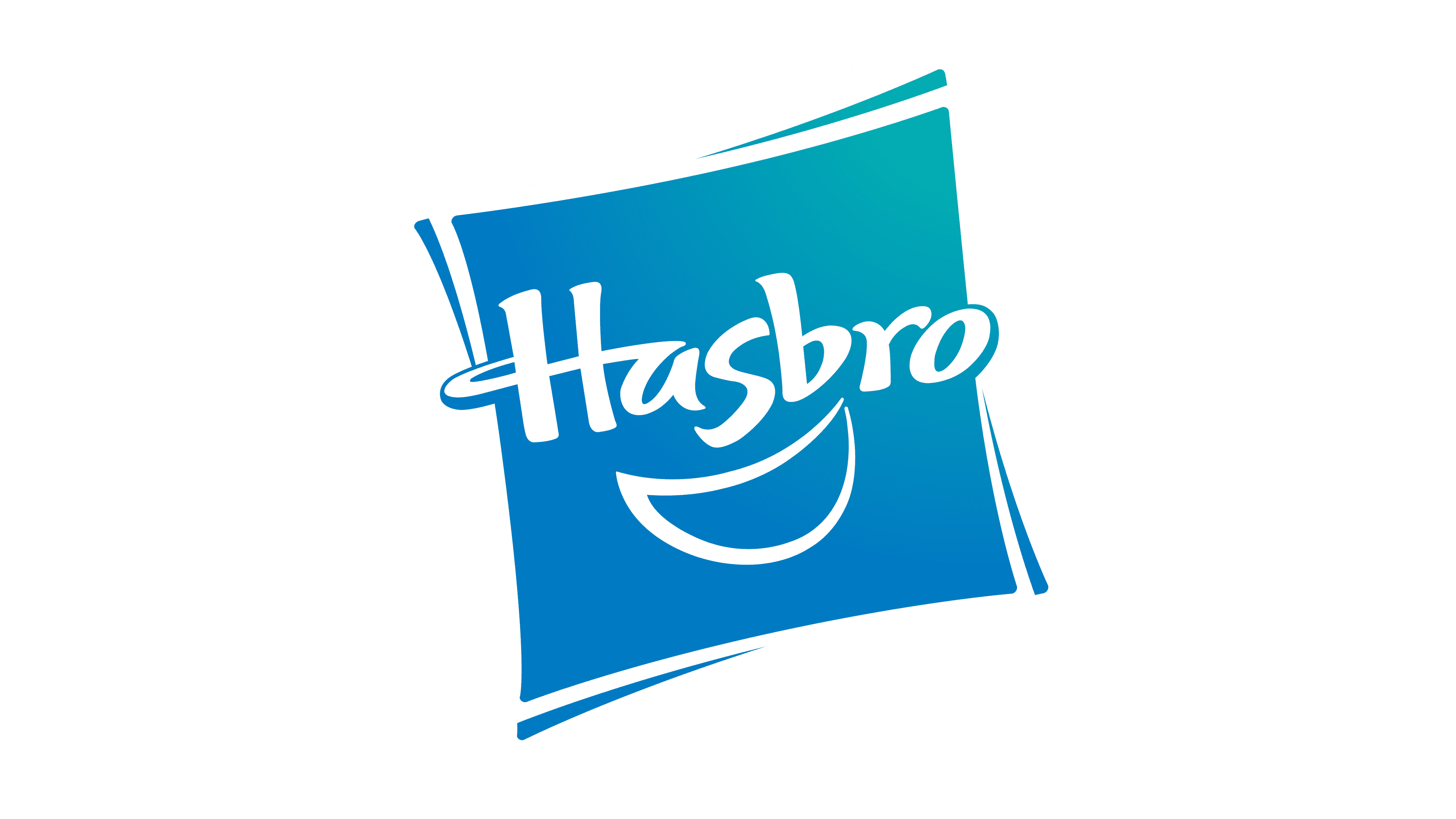Hasbro Logo
Hasbro, a prominent toy and board game company, currently excels in creating and marketing a diverse range of entertainment products. Renowned for iconic brands like Transformers, My Little Pony, and Monopoly, Hasbro has expanded its portfolio to include digital gaming and multimedia entertainment, catering to a global audience. The company operates in various international markets, with a significant presence in North America, Europe, and Asia. Ownership of Hasbro is public, with shares traded on the NASDAQ, involving a wide range of institutional and individual investors. This wide-reaching influence in both traditional and digital entertainment sectors positions Hasbro as a key player in the industry.
Meaning and history

A pivotal moment in Hasbro’s history was the launch of Mr. Potato Head in the 1950s, a groundbreaking toy that was the first to be advertised on television. This innovative marketing strategy revolutionized toy advertising and set a new standard in the industry. The 1960s witnessed another landmark with the introduction of G.I. Joe, pioneering the action figure segment.
Hasbro’s trajectory took a strategic turn in the late 20th century with key acquisitions, reshaping the landscape of the toy and game industry. The acquisition of Milton Bradley in the 1980s brought classic games like Twister under Hasbro’s umbrella, while the 1990s saw the addition of Tonka, Kenner, Parker Brothers, and the iconic Play-Doh brand. These acquisitions diversified Hasbro’s portfolio and cemented its position in the market.
The transition into the 21st century was marked by Hasbro’s foray into digital entertainment and multimedia, aligning with the digital revolution. The company embraced the era of digital gaming and online content, expanding beyond traditional toys and games.
Throughout its history, Hasbro’s ownership structure has evolved, transitioning to public ownership in the 1960s with its listing on the NASDAQ. The company has successfully navigated through various economic and market changes, demonstrating resilience and adaptability.
Hasbro is not just a toy manufacturer but a comprehensive entertainment provider, leveraging its classic brands into various media, including film and digital content. This evolution from a simple toy maker to an entertainment powerhouse highlights Hasbro’s innovative spirit and commitment to evolving with times, ensuring its relevance and appeal in a rapidly changing global market.
What is Hasbro?
Hasbro is a global powerhouse in the toy and entertainment industry, renowned for its diverse portfolio of iconic brands like Monopoly, Transformers, and My Little Pony. Blending traditional toy manufacturing with digital innovation, Hasbro transcends generations, offering immersive play experiences across various media platforms, including board games, digital gaming, and multimedia entertainment.
1923 – 1944
This logo features a handcrafted aesthetic with its irregular, stencil-like lettering spelling out “HASSENFELD BROTHERS, INC.” The uneven typographic style suggests a personal, human touch, indicative of the brand’s origins and early days. The use of all capital letters conveys a sense of solidity and presence, while the grayscale palette imparts a classic, timeless feel. This design likely reflects the company’s humble beginnings and its initial focus on textiles, prior to becoming the toy and game titan known as Hasbro. The logo’s simplicity and raw appearance contrast with the more polished and vibrant designs of later years, showcasing the evolution from a small family business to a global corporation. The inclusion of “BROTHERS, INC.” points to the company’s foundation by siblings, and the familial aspect that would be a cornerstone of the brand’s identity.
1944 – 1955
The logo depicts a bold, stylized ‘HB’ monogram encased within an oval frame, suggesting the initials of Hasbro. The fluidity of the letters conveys a sense of creativity and motion, resonating with the company’s dynamic approach to entertainment. Below the monogram, the word ‘HASBRO’ is inscribed in a solid, all-caps font on a ribbon-like banner, grounding the design with stability and prominence. The ‘INC’ suffix is neatly tucked at the oval’s base, indicating the corporate status of the entity. This design balances artistic flourish with corporate professionalism, embodying Hasbro’s legacy in the playful yet serious business of toys and games.
1955 – 1959
The logo presents the word ‘Hasbro’ in a free-flowing, cursive script that exudes a casual yet confident air. The brushstroke effect on the letters adds a creative flair, resonating with the imaginative essence of the company’s brand. Unlike its predecessor, this logo eschews additional graphics, focusing solely on the company name, which now takes center stage. The removal of the oval and the ‘HB’ monogram simplifies the design, reflecting a more modern and approachable image. This minimalist approach aligns with contemporary branding trends, emphasizing clarity and recognition. The logo’s simplicity ensures versatility across various platforms, a nod to Hasbro’s expansive reach in the digital and physical realms of entertainment.
1952 – 1968
This playful logo introduces a whimsical character, adding a personal touch to the Hasbro brand. The figure, depicted with a friendly, inviting smile, seems to personify the joy and innocence associated with the company’s products. Dressed in a collared shirt prominently featuring the Hasbro name, the character becomes a living embodiment of the brand, creating a direct connection with a younger audience. This logo departs significantly from the previous script-based design, moving towards a more narrative and character-driven branding strategy. The addition of a mascot adds a new dimension to the Hasbro identity, suggesting a world of stories and adventures behind the products. The registered trademark symbol, neatly placed beside the figure, underscores the company’s established and protected brand status. This evolution in branding reflects a strategic shift towards a more engaging and character-oriented approach to market to its core demographic: children.
1968 – 1977
The logo features a bold, geometric take on the ‘H’ of Hasbro, comprised of black and white triangular segments, creating a sense of dimensionality and modernity. This artistic choice represents a stark contrast to the previous character-based logo, signaling a shift towards a more abstract and sophisticated branding approach. The rest of the letters follow in a solid, sans-serif typeface, showcasing simplicity and a clean, contemporary aesthetic. The removal of any mascots or whimsical elements indicates a pivot in Hasbro’s visual identity strategy, perhaps aligning with a broader market or appealing to a more mature audience. This design choice embodies a corporate evolution, portraying Hasbro as not just a toy company, but a forward-thinking brand in the landscape of entertainment.
1977 – 1993
The logo portrays a heartwarming scene within a house silhouette, featuring a children, both central to Hasbro’s brand identity. This design marks a return to a character-centric logo, contrasting sharply with the previous abstract, geometric style. The house frame represents comfort and family, values that align with Hasbro’s mission to create experiences for children within the safety of their homes. The silhouette style is simplistic yet evocative, conveying a sense of play and imagination that resonates with Hasbro’s core audience. Beneath the house, the company’s name stands in bold, capitalized letters, asserting a strong, foundational presence. This logo iteration encapsulates Hasbro’s focus on nurturing, playful family environments, positioning their products as integral to home life. The overall design is both a nod to the nostalgia of childhood and a commitment to being a household name in family entertainment.
1993 – 1998
The logo features the word ‘HASBRO’ in a bold, capitalized, sans-serif font against a vibrant teal background, exuding a sense of freshness and modernity. This minimalistic design is a significant shift from the previous logo’s more illustrative approach, focusing purely on the brand’s name without any additional graphics or characters. The use of a single color and a clean typeface reflects a contemporary trend in logo design, prioritizing clarity and adaptability across various media. The teal color is distinctive, likely chosen for its association with creativity and reliability, qualities that Hasbro aims to embody. This logo iteration represents a streamlined brand identity, conveying Hasbro’s confidence and straightforwardness in the competitive landscape of entertainment and toy manufacturing.
1998 – 2009
The logo features the Hasbro name in a playful, italicized script, suggesting movement and dynamism, set against a teal backdrop. Below the script, a smiling crescent shape adds a touch of whimsy, reflecting the joy and fun associated with the brand’s products. This design marks a shift from the stark minimalism of the previous logo, reintroducing a graphic element that personifies the brand’s spirit. The tilted rectangle suggests a tag, which could imply branding on Hasbro’s myriad of toys and games. The teal color remains, providing brand continuity, yet the font and added smile infuse a more approachable and friendly vibe. This logo encapsulates a blend of fun and familiarity, aiming to resonate with consumers on an emotional level.
2008 – Today
The logo continues with the script typeface for ‘Hasbro’ but now introduces a gradient from white to a refreshing blue, creating a visual depth. The whimsical smile remains, yet it’s more integrated with the lettering, suggesting a seamless blend of fun and brand identity. This version is placed on a skewed blue background that adds a sense of innovation and a modern twist, signifying dynamism and a forward-thinking approach. The departure from the previous logo’s solid teal background to a gradient introduces a more contemporary feel, while the tilted perspective adds an element of playfulness. This iteration of the Hasbro logo keeps the fundamental elements but enhances them to convey a more energetic and vibrant brand personality.



















